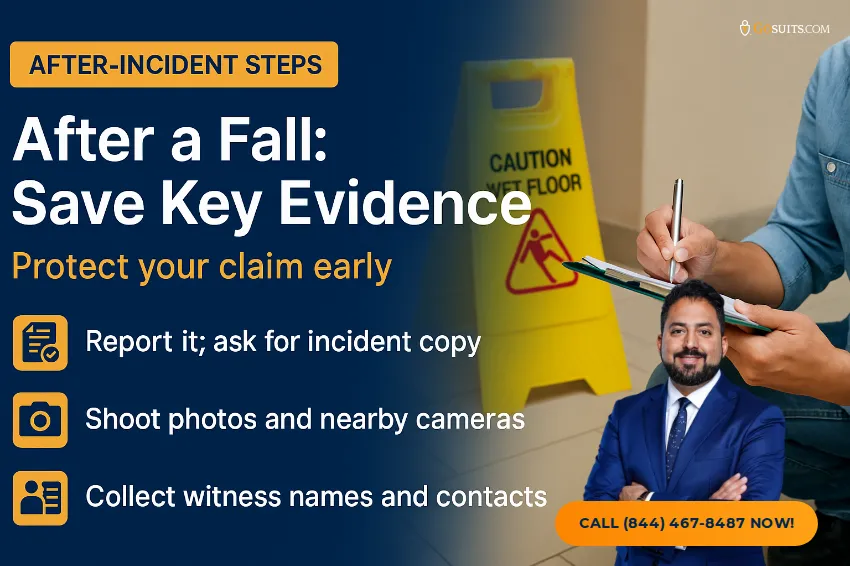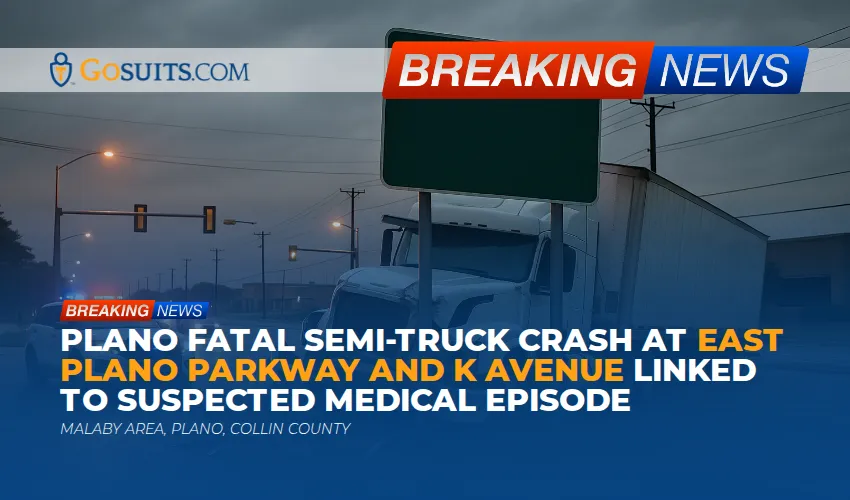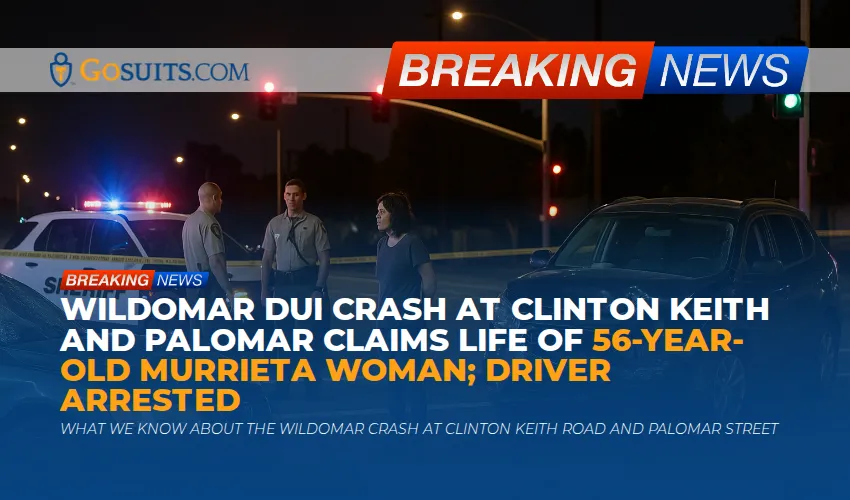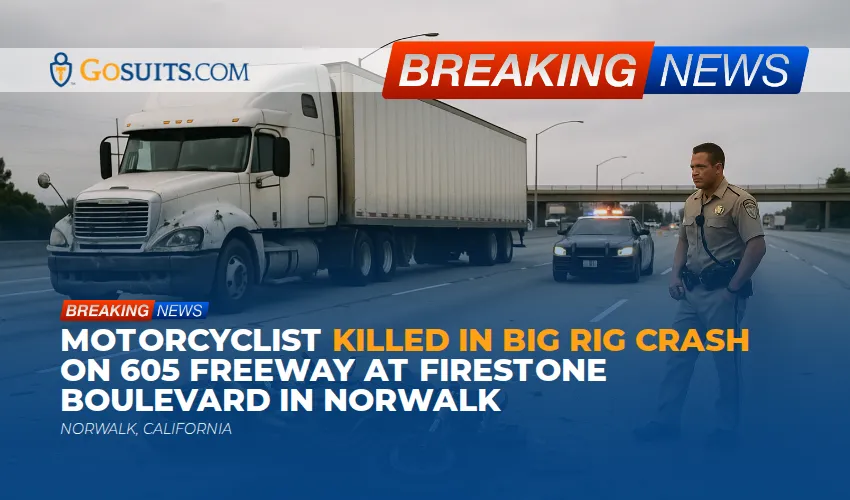- What do “constructive notice” and “actual notice” mean in premises liability?
- Why does the notice standard matter in a slip and fall or premises liability claim?
- How do you prove actual notice vs. constructive notice?
- What evidence can show constructive notice under the “knew or should have known” standard?
- How long must a dangerous condition exist to establish constructive notice?
- Do inspection policies, sweep logs, or surveillance video help prove notice?
- What do Texas courts require to prove notice in premises liability?
- What do California courts require to prove notice in premises liability?
- What do Illinois courts require to prove notice in premises liability?
- Who has the burden of proof on notice, and does it ever shift?
- How do comparative fault and “open and obvious” dangers affect notice and liability?
- What happens if a premises case is in federal court?
- What steps should you take after a fall to preserve notice evidence?
- How do property owners and insurers attack notice in litigation?
- Are there local considerations in Texas, California, and Illinois cities?
- How can GoSuits help with constructive vs. actual notice issues in your premises liability case?
- Resources
What do “constructive notice” and “actual notice” mean in premises liability?
Notice describes what the property owner or occupier knew about a dangerous condition before an injury happened. In civil premises liability cases, courts commonly recognize two types of notice:
- Actual notice means the owner or occupier actually knew about the hazard. Examples include an employee being told about a spill, seeing a broken step, or creating the hazard themselves. See “Notice” in the Cornell Legal Information Institute’s Wex resource, which distinguishes actual from constructive notice (law.cornell.edu/wex/notice).
- Constructive notice means the owner should have known about the hazard because it existed long enough or was sufficiently obvious that a reasonable inspection would have discovered it. This “should have known” concept appears in many premises liability discussions, including Cornell’s Wex entry for premises liability (law.cornell.edu/wex/premises_liability).
The difference between constructive and actual notice often determines whether a case survives summary judgment and reaches a jury, especially in slip and fall claims in grocery stores, big-box retailers, apartment complexes, hotels, and restaurants.

Why does the notice standard matter in a slip and fall or premises liability claim?
In most states, a plaintiff must prove the owner or occupier had actual or constructive knowledge of the unsafe condition and failed to fix it or warn about it. Without proof of notice, there is usually no liability. Cornell’s Wex primer explains that premises liability commonly requires showing the defendant knew or should have known of the problem and did not take reasonable steps to make the property safe (law.cornell.edu/wex/premises_liability).
Real-world impact:
- Plaintiffs need witness testimony, photos, video, maintenance logs, or inspection evidence to show how long a condition existed or that a store’s practices were inadequate.
Public health context underscores why this matters. Falls cause serious injuries nationwide. The Centers for Disease Control and Prevention reports that each year about 3 million older adults are treated in emergency departments for fall injuries, and over 800,000 patients a year are hospitalized because of a fall injury (cdc.gov/falls/facts). While not every fall involves premises liability, these numbers illustrate the frequency and potential severity of fall-related harm.
How do you prove actual notice vs. constructive notice?
Actual notice exists when the owner or its employee knew of the hazard. Proof often includes:
- Incident reports indicating a prior complaint about the same hazard.
- Witness testimony that an employee saw the condition or was told about it.
- Internal communications or maintenance tickets showing the condition was flagged for repair before the incident.
- Evidence the defendant created the hazard (for example, a worker mopped and left an area wet without signs).
Because actual notice is about what the defendant actually knew, documentation and credible testimony are critical. The Wex entry on notice describes actual notice as direct knowledge of a fact (law.cornell.edu/wex/notice).
What is constructive notice, and how is it different?
Constructive notice asks whether, under the circumstances, the owner should have known about the hazard. Proof frequently focuses on:
- Time-on-the-floor evidence suggesting the condition existed long enough that reasonable inspections would have found it.
- Inspection frequency and whether the business followed its own policies.
- Condition characteristics such as dirt tracks, footprints, or dried edges indicating age.
- Recurring or foreseeable hazards that call for heightened vigilance in a particular area.
Cornell’s Wex overview notes that liability often turns on whether the defendant knew or should have known about the dangerous condition (law.cornell.edu/wex/premises_liability).
What evidence can show constructive notice under the “knew or should have known” standard?
Courts commonly look for proof that the hazard was present for a sufficient time to be discoverable with reasonable care. Useful sources include:
- Surveillance video showing when a spill occurred and whether staff passed the area without action.
- Cleaning or “sweep” logs to establish when the last inspection occurred. Gaps can support constructive notice; a recent documented inspection may undercut it.
- Photos showing footprints, cart tracks, dried residue, or grime around a spill, suggesting age.
- Witness statements that the hazard was present earlier in the day or that employees walked through the area routinely.
- Store policies and training materials describing inspection intervals and employee responsibilities to identify hazards.
- Prior similar incidents in the same location, suggesting a recurring, foreseeable risk.
In grocery and retail settings, plaintiffs often combine several of these to build an inference of constructive notice. Defendants, in turn, highlight timely inspections or the sudden, unforeseeable nature of the hazard.
How long must a dangerous condition exist to establish constructive notice?
There is no single nationwide time threshold. The question is whether, under all the circumstances, the condition existed long enough that reasonable care would have discovered it. Some states emphasize the need for “temporal evidence” about how long the hazard existed. Others allow juries to infer constructive notice from inadequate inspection routines or evidence of recurring hazards. The underlying inquiry mirrors the general negligence duty reflected in California Civil Code section 1714, which imposes a duty to use ordinary care to avoid causing harm (leginfo.legislature.ca.gov), and aligns with the common definition of premises liability in Cornell’s Wex articles (law.cornell.edu/wex/premises_liability).
Do inspection policies, sweep logs, or surveillance video help prove notice?
Yes. Inspection evidence can be central to proving or disproving constructive notice.
- For plaintiffs: Long gaps between inspections, missing logs, or policies not followed can suggest that a hazard lasted long enough to be discovered. Video that captures the spill or shows staff bypassing the area supports the “should have known” argument.
Federal procedural rules sometimes determine whether a notice dispute gets decided by a judge or jury. Summary judgment is governed by Federal Rule of Civil Procedure 56, which allows judgment as a matter of law when there is no genuine dispute of material fact (law.cornell.edu/rules/frcp/rule_56).
What do Texas courts require to prove notice in premises liability?
What is the Texas standard for notice in slip and fall cases?
In Texas, plaintiffs generally must prove the owner or occupier had actual or constructive knowledge of the dangerous condition and failed to take reasonable care to reduce or eliminate the risk. Texas appellate decisions often emphasize the need for some evidence indicating how long the condition existed before the incident. Courts frequently describe this as a need for “temporal evidence.” A lack of proof on duration can be fatal to constructive notice.
Key concepts reflected in Texas case law include:
- Temporal evidence: Plaintiffs usually need evidence that a hazard was present long enough that a responsible inspection would have found it.
- Inspection practices: Stores with reasonable, documented inspections shortly before an incident may defeat constructive notice, whereas long gaps or missing records can support it.
- Creation of the hazard: If the defendant created the condition, this can satisfy notice without separate proof of time-on-the-floor.
To review Texas cases discussing temporal evidence and notice, see Texas Supreme Court decisions accessible through reliable caselaw databases such as Google Scholar searches for “Wal-Mart Stores, Inc. v. Reece, 81 S.W.3d 812 (Tex. 2002)” (scholar.google.com).
Does Texas use comparative responsibility in these cases?
Yes. Under the Texas proportionate responsibility statute, a plaintiff’s recovery may be reduced by their percentage of responsibility and is barred if their percentage exceeds 50 percent. See Texas Civil Practice and Remedies Code chapter 33 (statutes.capitol.texas.gov).
What do California courts require to prove notice in premises liability?
California’s general duty of ordinary care is codified at Civil Code section 1714, which provides that everyone is responsible for injuries caused by their lack of ordinary care in the management of property or person (leginfo.legislature.ca.gov).
How do California courts handle constructive notice in stores?
In retail slip and fall cases, California courts look at whether the owner used reasonable inspections to discover hazards. When plaintiffs show a failure to inspect within a reasonable time before the accident, a jury may infer that the condition existed long enough to be discovered by a proper inspection. For discussion of that principle, see California Supreme Court authority such as “Ortega v. Kmart Corp., 26 Cal.4th 1200 (2001),” searchable through Google Scholar (scholar.google.com).
Is California comparative fault pure?
California applies pure comparative fault, which reduces damages by the plaintiff’s percentage of fault. California’s comparative fault doctrine is longstanding in case law and is reflected in the state’s civil jury instructions on negligence and comparative fault published by the Judicial Council of California. For official access to those instructions and explanatory materials, see the Judicial Council’s CACI page (courts.ca.gov/partners/317.htm).
What do Illinois courts require to prove notice in premises liability?
What statute governs Illinois premises liability?
The Illinois Premises Liability Act, 740 ILCS 130, sets duties of care owed to lawful entrants on land. It addresses liability for injuries caused by conditions on property maintained by owners or occupiers (ilga.gov).
How is notice proven in Illinois?
Illinois law generally requires proof that a property owner had actual or constructive notice of the dangerous condition, unless the owner or its employees created it. Courts consider whether the hazard existed long enough to have been discovered in the exercise of ordinary care and sometimes evaluate “mode of operation” facts in self-service environments. For a sampling of Illinois appellate discussions of notice in retail slip and fall cases, you can review case law through Google Scholar searches such as “Donoho v. O’Connell’s, Inc., 18 Ill.2d 432” and “Olinger v. Great Atlantic & Pacific Tea Co., 21 Ill.2d 469” (scholar.google.com).
What is Illinois’s comparative negligence rule?
Illinois follows modified comparative negligence. Recovery is reduced by the plaintiff’s percentage of fault and barred if the plaintiff’s fault exceeds 50 percent, under 735 ILCS 5/2-1116 (ilga.gov).

Who has the burden of proof on notice, and does it ever shift?
In civil cases, the plaintiff bears the burden of proof by a preponderance of the evidence. The preponderance standard means the claim is more likely true than not true (law.cornell.edu/wex/preponderance_of_the_evidence).
On the issue of notice, the plaintiff must present evidence supporting actual or constructive knowledge. In some circumstances, evidence that a defendant failed to follow reasonable inspection practices can allow a jury to infer constructive notice. Conversely, defendants who produce credible proof of timely inspections may defeat an inference of constructive notice.
How do comparative fault and “open and obvious” dangers affect notice and liability?
- Texas: Recovery is barred if the plaintiff is more than 50 percent responsible. Otherwise, damages are reduced by the plaintiff’s percentage. See Tex. Civ. Prac. & Rem. Code ch. 33 (statutes.capitol.texas.gov).
- California: Uses pure comparative fault; damages are reduced proportionally. See the Judicial Council’s CACI materials addressing comparative fault concepts (courts.ca.gov).
- Illinois: Modified comparative negligence with a 51 percent bar. See 735 ILCS 5/2-1116 (ilga.gov).
What about “open and obvious” conditions?
States treat open and obvious conditions differently. The doctrine can limit or adjust a landowner’s duty in some contexts, or it may factor into comparative fault. Application is highly state-specific, so it is important to evaluate local precedent in the place where the incident occurred, whether that is Houston, Dallas, Austin, San Antonio, Fort Worth, Los Angeles, San Diego, San Jose, San Francisco, Sacramento, Chicago, Naperville, Springfield, Plano, Irvine, or Pasadena.
What happens if a premises case is in federal court?
Most premises liability claims are based on state law. If a case is filed in or removed to federal court under diversity jurisdiction, the federal court applies state substantive law under the principle articulated in Erie Railroad Co. v. Tompkins, 304 U.S. 64 (1938) (law.cornell.edu/supremecourt/text/304/64). Federal procedural rules govern how the case moves forward, including summary judgment under Federal Rule of Civil Procedure 56 (law.cornell.edu/rules/frcp/rule_56).
What steps should you take after a fall to preserve notice evidence?
If you are safe and able to do so, consider the following:
- Report the incident to the property manager and request that an incident report be created. Ask for a copy if possible.
- Document the scene with photos and video showing the hazard, your clothing and footwear, lighting, warning signs, and surveillance cameras in the area.
- Identify witnesses, gather names and contact information, and note any employee statements.
- Preserve physical evidence, such as damaged footwear or clothing.
- Seek medical care promptly and follow treatment plans; medical records help connect injuries to the incident.
- Consult a qualified injury attorney promptly to send preservation letters for surveillance video, inspection logs, and maintenance records. Video systems often overwrite footage quickly.
Timely action is especially important because constructive notice often hinges on evidence of how long a hazard existed and what inspections occurred.

How do property owners and insurers attack notice in litigation?
Common defense approaches include:
- Arguing lack of temporal evidence: Claiming there is no proof of how long the hazard existed.
- Pointing to timely inspections: Producing logs or testimony showing reasonable inspections occurred shortly before the incident.
- Challenging causation: Suggesting a different mechanism caused the fall or that the condition was not dangerous.
- Open and obvious defense: Arguing the danger was apparent and plaintiff should have avoided it, sometimes paired with comparative fault arguments.
- Disputing control or ownership: Asserting that a different entity controlled the area, which can affect duty and notice.
- Removal to federal court and seeking summary judgment under Rule 56 to test whether plaintiff’s evidence of notice is sufficient to create a triable issue (law.cornell.edu/rules/frcp/rule_56).
Are there local considerations in Texas, California, and Illinois cities? How should notice be evaluated in Texas cities like Houston, Dallas, Austin, San Antonio, Fort Worth, and Plano?
- Expect focus on duration: Texas courts often require some evidence of how long the hazard existed to support constructive notice. Collect video, witness statements, and logs early.
- Commercial property practices: In busy retail hubs in Houston and Dallas, written sweep policies help both sides show what is reasonable. Plaintiffs should request them promptly.
- Comparative responsibility: Keep footwear, photograph lighting and signage, and document any distractions. These facts influence fault allocations under chapter 33.
How should notice be evaluated in California cities like Los Angeles, San Diego, San Jose, San Francisco, Sacramento, Irvine, and Pasadena?
- Inspection intervals matter: California juries may infer constructive notice if reasonable inspections did not occur within a suitable time before the fall. Preserve logs and staff schedules.
- High-traffic venues: In large stores and shopping centers, inspection frequency, staffing, and foreseeable hazards are often central to the case.
- Pure comparative fault: Evidence of distraction or visibility goes to apportionment, not necessarily a complete bar to recovery.
How should notice be evaluated in Illinois cities like Chicago, Naperville, and Springfield?
- Statutory framework: The Illinois Premises Liability Act governs. Identify whether the owner created the condition or had actual or constructive knowledge (740 ILCS 130).
- Self-service settings: Facts about a store’s mode of operation and recurring hazards can influence constructive notice analyses. Gather incident histories and area-specific policies.
- Modified comparative negligence: Document both hazard characteristics and your path of travel to address fault allocation under 735 ILCS 5/2-1116.
How can GoSuits help with constructive vs. actual notice issues in your premises liability case?
You do not have to navigate notice rules on your own. The difference between constructive and actual notice can decide whether a case gets dismissed or goes to a jury. We focus on thorough investigations, early evidence preservation, and clear storytelling about what the property owner knew or should have known. Here is how we support you right away, statewide and near you in Texas, California, and Illinois.
What availability and communication do we offer?
- Available 24/7: You can reach us any time for an immediate free consultation. An attorney and staff member are available at all of our locations around the clock to start protecting time-sensitive evidence such as surveillance footage and sweep logs.
- Multilingual support: We provide multilingual customer service. Spanish and Farsi speakers are available 24/7. If you prefer to communicate in another language, we can accommodate that as well.
What are our fee policies and cost transparency?
- No win, No Attorney Fees: Learn about our approach to contingency fees here: No win, No Attorney Fees.
- No hidden administrative fees: We clearly explain costs and case milestones so you understand how resources are used to build your claim.
How do our tools and case workflow help your claim?
- Proprietary case software: We developed in-house personal injury software for our team’s use. It helps us track critical notice evidence, analyze inspection gaps, organize surveillance timelines, and streamline demands and litigation. We are a law firm that uses technology to stay ahead of insurers and large corporate defendants.
- Faster investigation: Our workflow prioritizes early preservation letters, rapid FOIA or public-record requests when appropriate, and structured interviews that focus on facts courts consider in notice disputes.
- Litigation readiness: From negotiation to discovery, we organize inspection policies, training materials, vendor maintenance contracts, and video metadata in formats designed to be persuasive at mediation and trial.

What is our experience and track record?
- 30 years of combined experience: Our attorneys have litigated well over 1,000 cases, with settlement and verdict results published on our website. Review past matters here: gosuits.com/prior-cases.
- Severe injury focus: We litigate complex cases in Texas, California, and Illinois, including product defect claims, 18-wheeler collisions, and brain and spinal injuries. When needed, we retain qualified professional witnesses in the state to analyze liability and damages in a way that aligns with local rules of evidence.
- Awards: Recognitions include listings by TopVerdict for settlements and verdicts across multiple U.S. counties, a Top 100 Settlement in Texas, National Trial Lawyers Top 40 Under 40 for Sean Chalaki, recognition by Best Lawyers in 2023–2025, and Super Lawyers since 2021. These honors reflect past work and are not a guarantee of future outcomes.
How do we staff cases, and what makes us different?
- Quality over volume: We are not a volume firm. Your case receives individualized attention, with a plan tailored to the notice issues at play in your jurisdiction.
- Hands-on case strategy: Attorneys stay engaged with you and your file. We schedule regular updates, provide clear timelines, and involve you in strategic decisions such as whether to file suit, when to notice depositions, and how to approach mediation.
Where are we located, and how can we help immediately?
- Texas: Serving clients statewide, including Houston, Dallas, Austin, San Antonio, Fort Worth, and Plano. We act quickly to secure store videos and inspection records and to identify all potentially responsible parties.
- California: Serving Los Angeles, San Diego, San Jose, San Francisco, Sacramento, Irvine, Pasadena, and surrounding areas. We scrutinize inspection routines and training evidence often central to constructive notice disputes in retail and hospitality settings.
- Illinois: Serving Chicago, Naperville, Springfield, and beyond. We examine Premises Liability Act issues, control of the area, and prior incidents to establish notice.
From the first call, we move to preserve evidence and clarify whether the case will turn on constructive or actual notice, the premises liability burden of proof, and how local courts in your city apply these standards. We are available now to listen, evaluate next steps, and start building the proof you need.
Resources
- Cornell Law School, Legal Information Institute, Wex: Notice. https://www.law.cornell.edu/wex/notice
- Cornell Law School, Legal Information Institute, Wex: Premises liability. https://www.law.cornell.edu/wex/premises_liability
- Cornell Law School, Legal Information Institute: Preponderance of the evidence. https://www.law.cornell.edu/wex/preponderance_of_the_evidence
- Cornell Law School, Legal Information Institute: Federal Rule of Civil Procedure 56. https://www.law.cornell.edu/rules/frcp/rule_56
- Erie Railroad Co. v. Tompkins, 304 U.S. 64 (1938). https://www.law.cornell.edu/supremecourt/text/304/64
- California Civil Code § 1714. https://leginfo.legislature.ca.gov/faces/codes_displaySection.xhtml?sectionNum=1714.&lawCode=CIV
- Judicial Council of California, CACI resources. https://www.courts.ca.gov/partners/317.htm
- Illinois Premises Liability Act, 740 ILCS 130. https://www.ilga.gov/legislation/ilcs/ilcs3.asp?ActID=2060&ChapterID=56
- Illinois comparative negligence statute, 735 ILCS 5/2-1116. https://www.ilga.gov/legislation/ilcs/documents/073500050K2-1116.htm
- Texas proportionate responsibility statute, Tex. Civ. Prac. & Rem. Code ch. 33. https://statutes.capitol.texas.gov/Docs/CP/htm/CP.33.htm
- California Supreme Court, Ortega v. Kmart Corp. (searchable via Google Scholar). https://scholar.google.com/scholar?q=Ortega+v.+Kmart+Corp.+26+Cal.4th+1200
- Texas Supreme Court, Wal-Mart Stores, Inc. v. Reece (searchable via Google Scholar). https://scholar.google.com/scholar?q=Wal-Mart+Stores%2C+Inc.+v.+Reece+81+S.W.3d+812
- Illinois Supreme Court, Donoho v. O’Connell’s, Inc. (searchable via Google Scholar). https://scholar.google.com/scholar?q=Donoho+v+O%E2%80%99Connell%E2%80%99s,+Inc.,+18+Ill.2d+432
- Centers for Disease Control and Prevention, Falls Data and Statistics. https://www.cdc.gov/falls/facts.html






